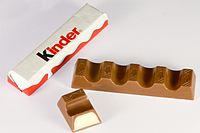Kinder Chocolate
This article needs additional citations for verification. (September 2014) |
 One Kinder Chocolate bar = 12.5 g | |
| Nutritional value per 100 g (3.5 oz) | |
|---|---|
| Energy | 2,360 kJ (560 kcal) |
53.5 g | |
| Sugars | 53.0 g |
34.8 g | |
| Saturated | 22.6 g |
8.7 g | |
| Minerals | Quantity %DV† |
| Sodium | 37% 853 mg |
| †Percentages estimated using US recommendations for adults,[1] except for potassium, which is estimated based on expert recommendation from the National Academies.[2] | |
Kinder Chocolate ("Kinder" is German for "children") is a confectionery product brand line of Italian confectionery multinational Ferrero SpA. Kinder was developed and produced at Ferrero Germany (Frankfurt) in 1967 for the German market. One year later (in 1968) it was sold in Italy, before reaching the countries along the Mediterranean Sea.
Products
- Kinder Bueno is a duo set of chocolate wafer bars containing a hazelnut cream filling and was released in the United Kingdom in 1999. These were marketed as the 'first Kinder chocolate for adults', and have gained the Kinder brand greater recognition in the UK. Kinder introduced a white chocolate version of Bueno in 2008. 2017 saw the release of the coconut and dark chocolate variants of the Kinder Bueno.
- Kinder Surprise is a hollow milk chocolate egg shell containing a toy. The outside surface of the egg is milk chocolate, and the inside is a milky interior.[3] A capsule containing a toy is inside the chocolate egg.
- Kinder Joy is similar in shape to the Kinder Surprise, it has a plastic egg-shaped packaging that is internally divided into two halves. One half contains two soft creamy chocolate layers, one milk-chocolate flavoured, one white-chocolate flavoured, which are eaten with an included spoon. Embedded in the ganache are two round, chocolate-covered wafers, which are filled with the same hazelnut cream found in Kinder Bueno. The other half contains a small toy.
- Happy Hippos are a wafer coated hippo-shaped biscuit, filled with both a white filling and a hazelnut filling. Happy Hippos are also available in Chocolate flavour.
- Kinder Chocolate is a fine milk chocolate with a milky filling, ranging from 4 to 40 bars.
- Kinder Delice is a chocolate cake with a layer of milk inside and a milk chocolate covering.
- Kinder Pingui is similar to Kinder Delice with the exception of a complete chocolate covering and more milky filling inside.
- Milky Bites are small milk chocolate eggs, with a hazelnut and white chocolate filling and are also known as 'Schoko-Bons'.
- Country Crisp, similar to the Kinder Schokolade, containing small pieces of cereal and grain within the chocolate filling, as well as a wafer casing. (Also known under the name 'Kinder Country' and 'Kinder Cereali').
- Kinder Maxi is a larger version of the Kinder Chocolate.
- Kinder Riegel is a milk chocolate stick with extra creamy milk filling.
- Kinder Maxi King is a milk cake with a layer of caramel inside and a hazelnut chocolate covering.
- Kinder Paradiso is a slightly lemon flavoured sponge cake, with a creamy milk filling in between and powdered sugar on the top.
- Kinder Milk Slice is a chocolate sponge cake that has a creamy, milky filling in the middle.
- Kinder ChocoFresh is a 2 layered chocolate bar. In the bottom, a layer of hazelnut cream then, a whipped cream base, then its coated with pure chocolate. (Available in some European countries)
Sponsor
Kinder sponsors the Spanish, Italian and Portuguese national volleyball teams.
References
- ^ United States Food and Drug Administration (2024). "Daily Value on the Nutrition and Supplement Facts Labels". Retrieved 2024-03-28.
- ^ National Academies of Sciences, Engineering, and Medicine; Health and Medicine Division; Food and Nutrition Board; Committee to Review the Dietary Reference Intakes for Sodium and Potassium (2019). Oria, Maria; Harrison, Meghan; Stallings, Virginia A. (eds.). Dietary Reference Intakes for Sodium and Potassium. The National Academies Collection: Reports funded by National Institutes of Health. Washington, DC: National Academies Press (US). ISBN 978-0-309-48834-1. PMID 30844154.
- ^ http://kinderbrands.com.au/faq/
External links
- Ferrero Products - Kinder
- kindercioccolato.it official Kinder site (in Italian)
- Markenmuseum history of Kinder
